
Once upon a time there was a beautiful painting
called STELLA, a formal reclining nude rendered
at life size. All who saw her agreed that STELLA was
remarkably, uncommonly, unquestionably realistic.
AND BEAUTIFUL!
She became the must-see sensation of San Francisco's
1915 PANAMA-PACIFIC INTERNATIONAL EXPOSITION,
the last of the great Beaux-Arts expositions. Nearly
19,000,000 people came to marvel at its wonders.

STELLA could be found in the Joy Zone, the fair's lavish midway. Her
modest pavilion nestled under one shoulder of the monumental facade
of the five-acre working model Panama Canal. STELLA's entrance is at right.

"HAVE YOU SEEN STELLA?"
This was the catchphrase, and how it caught! Attendance was given early
stimulation by a largesse of free admissions. Thousands upon thousands
paid ten cents apiece to file through STELLA'S little dark theater and
gaze upon her chaste nakedness, while a lecturer recited her history.
And no one seemed to go away disappointed.

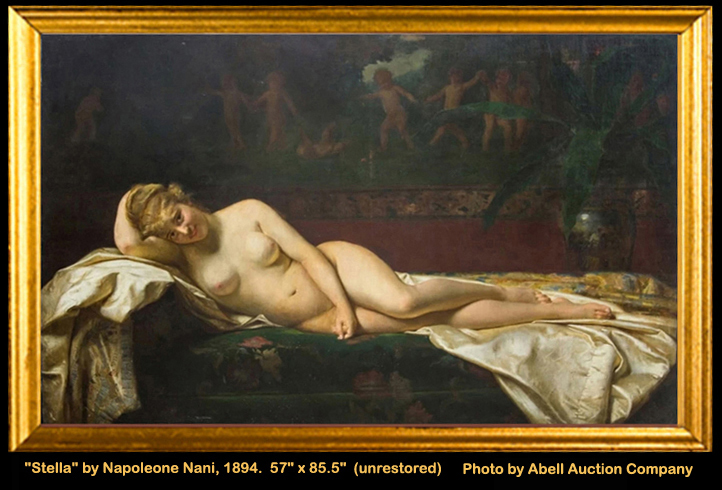

A few outsiders were baffled by STELLA's success, for it was true
that without sacrificing so much as a single dime, any fairgoer could
repair to the Palace of Fine Arts and see thousands of works of art
from around the world, including a number of quite pleasing nudes.

Of course, most of the more recent representations of the 'female
form divine' were not classical realist works; at that time official
praise and prizes were chiefly lavished upon the many modern
impressionists still in fashion. Such realism was not their intent.

Some haughty esthetes rejected STELLA as not being Fine Art.
There were even those who sneered, and loftily dismissed her
as no more than a 'barroom nude'. But hundreds of thousands
looked upon her and found her wonderful. It was not merely that
she was beautiful and lifelike; simply put, STELLA was lovable.

STELLA's visitors received a card with this inscription:

It says much about this era that another 'nude' was enjoying fame
nearly comparable to STELLA's at the San Francisco fair. People were
marveling at Marcel Duchamp's startling Cubist-Modernist-Futurist
or Post-Impressionist (no one seemed entirely certain exactly how to
categorize it at first) "NUDE DESCENDING A STAIRCASE" from 1912.

To most visitors, Duchamp's "Nude" was merely a novelty,
while STELLA captured the hearts of those who gazed upon
her. Saturation publicity, with "HAVE YOU SEEN STELLA?"
blazoned throughout the fair and out into the city, did help
create interest, but it wasn't all that made her so memorable.
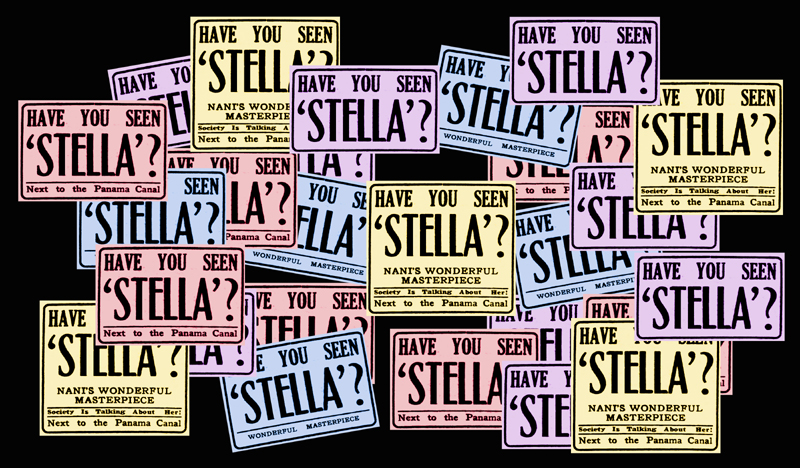

~ ~ ~ ~ ~ ~ ~ ~ ~ ~ ~
~ ~ ~ ~ ~ ~ ~ ~ ~ ~
STELLA could inspire the most heartfelt of tributes:
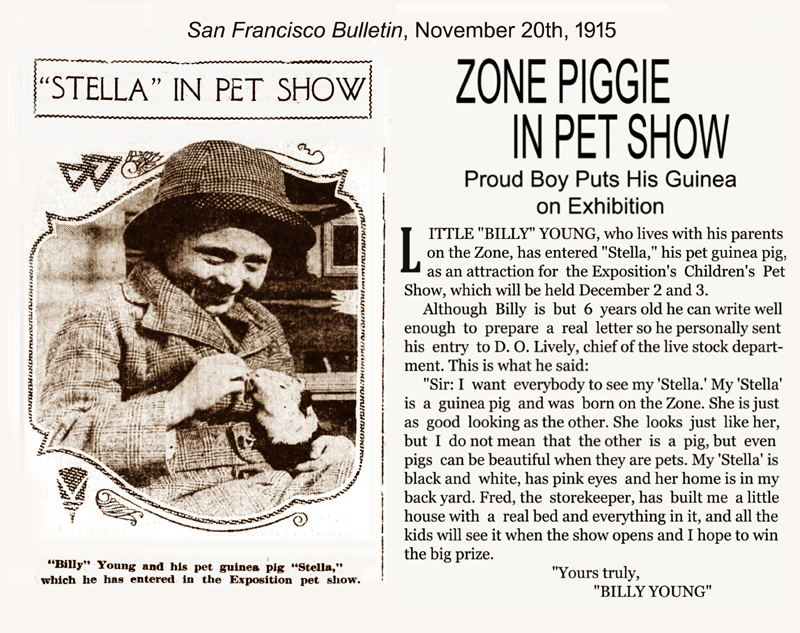
STELLA was everywhere! Even the cartoon world was not immune:

The cartoonists themselves predictably (though rather unfairly)
represented STELLA as no more than a naughty picture, a sort of
'girlie' show on canvas only appealing to the male of the species.
Arthur Milman devoted sixty panels of his obnoxious troublemaker
'Steve Bunk' to Steve's adventures at the fair. Steve saw STELLA!

 When George McManus, creator of the long-running "Bringing Up Father"
When George McManus, creator of the long-running "Bringing Up Father"
came west to the Exposition, of course Maggie and Jiggs followed suit.

Surely the incorrigible Jiggs would be eager for a look at STELLA!
But he was new to the fair and had somehow missed her publicity.
The Scenic Railway, however, interested him immediately.

Finally a jaunt to the sunny Southland was proposed...

Jiggs was unimpressed with Los Angeles-- until he saw the ocean.

But once he realized how much he'd missed in San Francisco--

Of course such a sincere art lover (and skirt chaser) as Jiggs just
had to see STELLA. And if she had no skirt to chase, all the better!
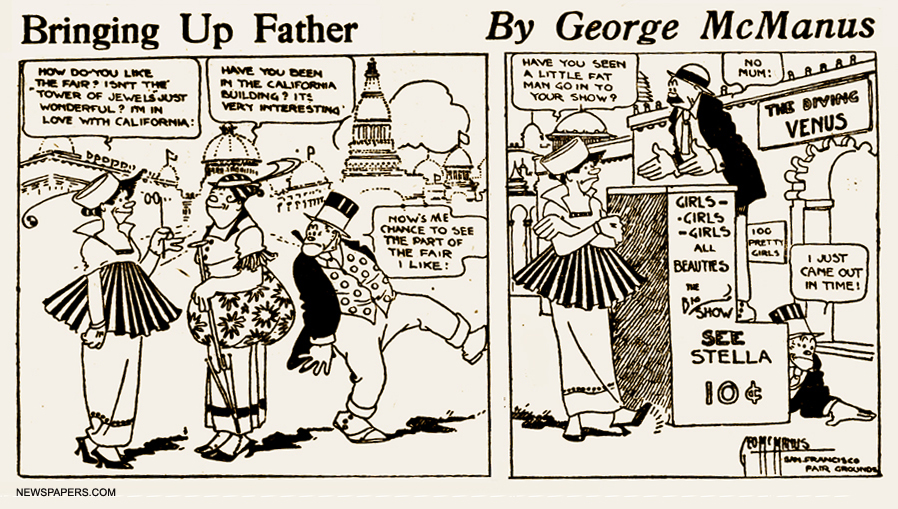
~ ~ ~ ~ ~ ~ ~ ~ ~ ~
~ ~ ~ ~ ~ ~ ~ ~ ~ ~ ~
"Have You Seen Stella" became the title of more than one musical
comedy, and it seemed that every amusement park or fair's carnival
midway had an attraction called 'Stella'. At Coney Island's Luna Park,
'Stella' was a woman "in white tights who poses in front of a lantern
which throws queerly colored decorations over and about her."
~ ~ ~ ~ ~ ~ ~ ~ ~ ~
~ ~ ~ ~ ~ ~ ~ ~ ~ ~ ~
All MANNER OF CELEBRITIES VISITED THE FAIR
AND WERE CHARMED BY THE SMILING NUDE.
Lightweight Champion BATTLING NELSON, "the Durable Dane",
in 1915 was considered one of the greatest fighters in boxing history.

~ ~ ~ ~ ~ ~ ~ ~ ~ ~ ~
~ ~ ~ ~ ~ ~ ~ ~ ~ ~
Also among STELLA's visitors were two great friends, giants in
the shaping of 20th-century civilization: electrical wizard
Thomas Alva Edison and mechanical genius Henry Ford.

Edison had designed the recorded commentary via telephone
receiver that regaled riders on the 24-minute tour of the Canal
attraction, and was justly pleased. There seems to be no record
of what he and Ford thought of STELLA. Their picture was taken
as they exited her pavilion, an image that has proved elusive.

~ ~ ~ ~ ~ ~ ~ ~ ~ ~ ~
~ ~ ~ ~ ~ ~ ~ ~ ~ ~
Everyone remembered beloved stage star Anna Held:
big eyes, big hair, big hats, and hourglass figure ~
Florenz Ziegfeld's sparkling Gallic protegee.

Anna, a little older and just as charming, had taken a break from war
work in Europe to tour in Orpheum vaudeville. Near the end of the fair
she visited the Zone, found STELLA utterly enchanting, and exclaimed:

~ ~ ~ ~ ~ ~ ~ ~ ~ ~ ~
~ ~ ~ ~ ~ ~ ~ ~ ~ ~
THE MONACO CAPER
In a daring act of Exposition espionage, immigrant photographer
J.B. Monaco, celebrated for his fine images of the 1906 earthquake,
conceived an audacious plan to obtain a photo of the famous STELLA.
He may have asked permission to set up his camera and been refused.
Luckily, he was not so easily discouraged.
With a friend who worked at the fair as accomplice, one night they
entered behind STELLA's pavilion and drilled a hole in the back wall
large enough to admit a camera lens. By the rather warm light used
for the display, Monaco made a time exposure. Between the lighting
and the orthochromatic nature of earlier photographic stock, the
tonal values were clearly altered. The resultant image is rather eerie.

Still, it does establish without question exactly which STELLA
was at the Exposition, an issue that would later be hotly debated.
~ ~ ~ ~ ~ ~ ~ ~ ~ ~ ~
~ ~ ~ ~ ~ ~ ~ ~ ~ ~

San Diego had a great Exposition in 1915 too-- but no STELLA.
~ ~ ~ ~ ~ ~ ~ ~ ~ ~ ~
~ ~ ~ ~ ~ ~ ~ ~ ~ ~
Once the SF fair had closed STELLA journeyed south, and for
months drew admiring crowds in downtown Los Angeles.

After more than three months in Los Angeles, STELLA
returned to San Francisco for a last exhibition downtown.

When the San Diego Fair was continued through 1916, there
was talk of STELLA appearing there, but alas! it was not to be.
However, San Diegans were not entirely deprived of a view, as
STELLA obligingly journeyed south once more to be exhibited.
Thousands seized the opportunity to visit the Spreckels Theatre
Building for a long-awaited glimpse of the famous canvas over
the course of two and a half weeks. San Diego loved STELLA!

After a last California appearance in Sacramento, STELLA
boarded a train for the East Coast and fresh conquests.
Some years would pass before she'd be seen on the West Coast again.
~ ~ ~ ~ ~ ~ ~ ~ ~ ~
~ ~ ~ ~ ~ ~ ~ ~ ~ ~ ~
America hadn't yet entered the Great War, but there was
considerable effort expended in providing humanitarian aid
to stricken Europe. What more natural than that Little Mary,
America's Sweetheart, and STELLA, the Sweetheart of the
Exposition, should pitch in together for this worthy cause?

The presence of STELLA and Mary Pickford surely helped
the gala Allied Bazaar in New York's Grand Central Palace
to enjoy such success that it was held over an extra week.

Seeing the photo of Thomas Edison and Henry Ford emerging
from STELLA's pavilion at the San Francisco fair, the public
was assured that no possible loss of respectability could attach
to venturing inside for a glimpse of Nani's famous canvas.
During this high-powered event vistors could also see in person
Will Rogers, Marie Dressler, Elsie Janis, Irving Berlin, Jane Cowl,
Ethel Barrymore, Laurette Taylor, Louise Dresser, Sir Herbert Tree,
Constance Collier, Vaslav Nijinsky, Alla Nazimova, Emma Calve...
Helen Keller too appeared. And Anna Held and STELLA met again.

~ ~ ~ ~ ~ ~ ~ ~ ~ ~
~ ~ ~ ~ ~ ~ ~ ~ ~ ~ ~
Note that in the New York Times item above, STELLA's
origin is simply and accurately given: she was painted for
John T. Milliken by Napoleone Nani. No one could have
predicted that innocent STELLA's legend would soon pass
into the hands of liars, wishful thinkers and delusionals.
There was only one authentic original STELLA,
but her success proved such an inspiration to
ambitious imitators that multiple claimants to
her fame and fabled lifelike beauty materialized
far and wide in the years following the 1915 fair.
 The public's credulity was at times severely taxed.
The public's credulity was at times severely taxed.
Some were obvious copies, with a similar setting and
pose, while others were simply reclining nudes with no
actual resemblance to STELLA. Some really had hung in
barrooms or saloons. A number of hungry artists came
forward, insisting they'd painted the original. Innocent
cases of mistaken identity swelled the roster as well.

In general, these would-be 'Stellas' faded into obscurity
over time, but a few did survive to surface periodically
--and greatly confuse the historical record.
The most enduring of them enjoyed a long career in
San Francisco Bay Area restaurants and night spots,
garnering local attention and affection for decades.
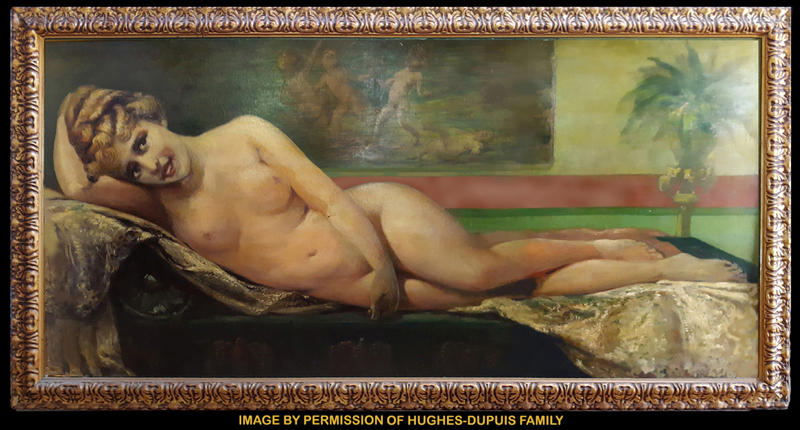
Much was made of her possessing two left feet.

Even 'Mr. San Francisco', columnist Herb Caen, endorsed her.

Her identity seemed secure when two generations after the 1915
fair, 'Lefty' was featured in the highly-regarded documentary,
"The Innocent Fair". For thousands too young to remember 1915,
and many unable to clearly recall a few minutes' glimpse from a
half century before, this naive and larger-than-life copy was the
undisputed 1915 World's Fair STELLA. It supported the idea that
there was some trickery involved in STELLA's vaunted realism.
For decades 'Lefty' reigned supreme as San Francisco's 'Stella'.
But she still wasn't the real thing.

Views of 'Lefty' did much to lower STELLA's prestige over the years,
while to many there seemed no hard evidence to disprove 'Lefty's' claim.
~ ~ ~ ~ ~ ~ ~ ~ ~ ~ ~ ~
~ ~ ~ ~ ~ ~ ~ ~ ~
STELLA herself, having wandered far from San Francisco, found fresh
opportunities elsewhere. From 1916 to 1923 she appeared at fairs,
carnivals and special events across the United States and Canada.
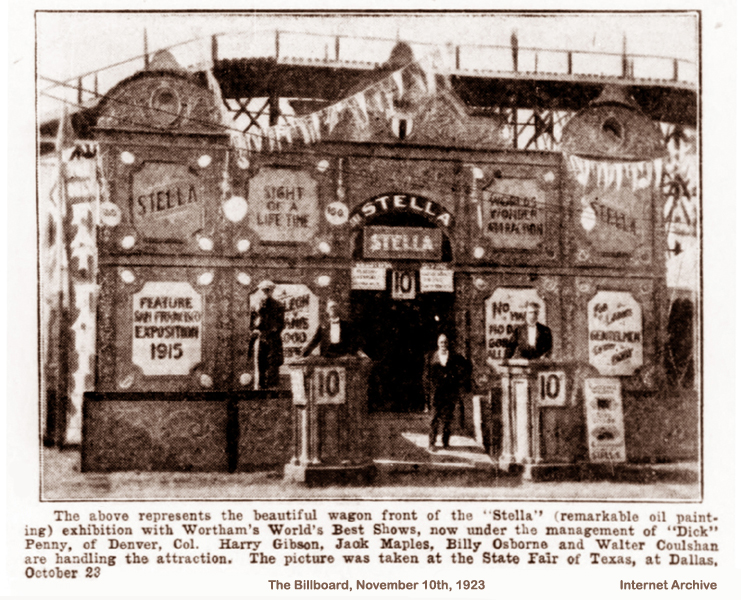
In 1924 STELLA came back to California and changed hands,
finding welcome retirement from the on-the-road carnival life
under the management of movie-house mogul Claude Langley.
~ ~ ~ ~ ~ ~ ~ ~ ~ ~ ~
~ ~ ~ ~ ~ ~ ~ ~ ~ ~
The world of the midway went on without STELLA, though
not entirely. There was still magic --and money-- in her name.

To make up for no STELLA in 1916, San Diego's 1935
World's Fair featured not merely one, but TWO 'Stellas',
both exhibitors insisting theirs was the one and only
original unquestionable bona fide and genuine article.
And of course neither was.
 Plans were going forward for the 1939 World's Fair.
Plans were going forward for the 1939 World's Fair.


When STELLA was to join the attractions at The Golden Gate
International Exposition, no fewer than FOUR different 'Stellas'
were offered to the fair. Three were quite plainly poor imitations,
while the fourth was indeed STELLA, unquestionably STELLA, the
famous icon of the 1915 fair. She then assumed her rightful place
at Treasure Island's raucous 'Gayway', perhaps a dubious honor.

The setting was decidedly less tasteful than in 1915,
with admission again the same 'tenth part of a dollar'.
After dark, "HAVE YOU SEEN STELLA?" was boldly
spelled out in bright neon tubing. It was a new era.

Life magazine visited the fair and published a very misleading
account of STELLA, evidently using image and description of an
earlier counterfeit from Life's photo files. This was obviously an
existing nude converted into a 'Stella', probably equipped with a
simple breathing device as described. The Life photographer did
take a shot of the STELLA concession's exterior, possibly without
glancing inside. STELLA's place in history was usurped yet again.

Nonetheless,
STELLA's winsome appeal proved enduring, despite saucy
competition from Irving Sinclair's painted-on-glass "Gloria,
the 1939 Nude", who enticed customers in at the other end of
the Gayway with ingenious lighting effects, including a sort of
rippling over "Gloria's" torso that made her seem to breathe.

However,
neither could equal the popularity of the very much alive and
in-the-flesh cowgirls of Sally Rand's Nude Ranch, to whom
the Life photographer devoted considerable time and film.

After the Treasure Island fair closed in 1940, STELLA seemingly
vanished from the public eye (at least to Northern Californians),
to await a future unveiling for another generation at yet another
World's Fair. While STELLA lay hidden in her steel shipping case in
the Southland, her imitators had free rein, and made the most of it.
BUT...
Whatever became of those three rejected 'Stellas'?
~ ~ ~ ~ ~ ~ ~ ~ ~ ~
~ ~ ~ ~ ~ ~ ~ ~ ~ ~ ~

Mrs. Langley-Mitchell still puzzled over where STELLA properly belonged.
In 1960 a reporter visited, and quipped that Nani's unclad maiden "has
earned more than three million dollars, but hasn't a stitch to show for it."

At long last, opportunity knocked.
STELLA now departed California, north to Washington state and
a completely alien world, the Ultra-Modern Futuristic Space Age
CENTURY 21 EXPOSITION-- THE SEATTLE WORLD'S FAIR of 1962.
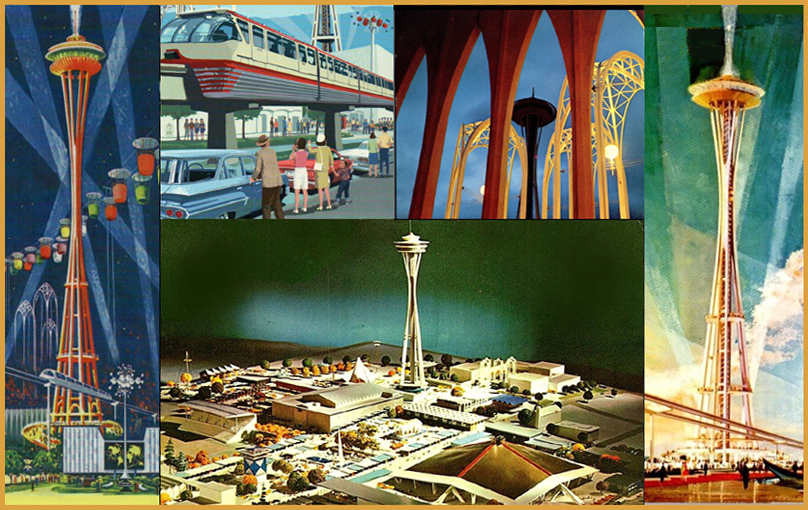
The Fair's theme was the exciting World of Tomorrow,
with science, technology, space travel-- but even the
World of Tomorrow, it seemed, needed naked ladies.
In the shadow of the towering Space Needle, the 'female
form divine', whether of flesh or of canvas and paint, was
celebrated in the very cosmopolitan nightlife to be found on
Show Street. This adult midway was very sensibly separated
from that for families, and thus the 'Gayway' at Seattle was
devoted to amusement park rides and other wholesome fun.

On sophisticated Show Street there were polished
high-end touring productions in the continental style
of the Folies-Bergere and Lido shows, rather spicy...

Some of the adult entertainments were in fact deemed
entirely too spicy, and consequently more than once
found themselves falling afoul of the local censors.

STELLA was installed as the star of a small gallery, in company
with a few lesser nudes: admission 50 cents. Out of place amongst
the peep shows, the nudie revues and risque French puppets, the
demure STELLA was admired as a quaint vision from the past. The
censors ignored her as harmless and no threat to public morals.

STELLA's promoters decided that something was
needed to add a bit more dazzle to their attraction,
so to spice up the display, STELLA was shown side
by side with a live duplication of the painting's pose
and setting. Behind a pane of glass on a velvet couch,
a model did her best to emulate the original-- but it
was STELLA who looked by far the livelier of the two.
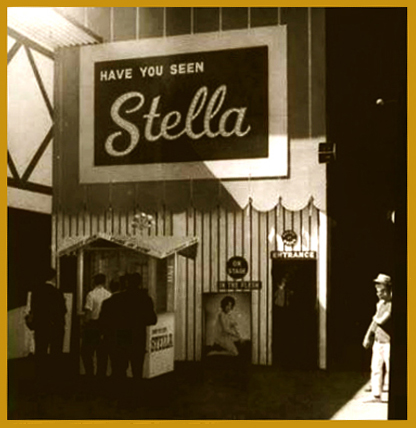

The Fair's general manager was unimpressed, and after
a couple of months cut admission from 50 to 25 cents.
"We didn't think it was worth fifty cents," he explained.

The six months of the Fair finally drew to a close in October.
After this, STELLA had had quite enough of World's Fairs
and tawdry midways, and quietly returned to California.


By the late '60s a brisk rivalry had sprung up between
north and south. There were still too many 'Stellas'.

In 1972 STELLA was sold to the House of Props in Hollywood,
and embarked on a new career as artistic set dressing for a
number of motion pictures, which we are hoping to identify.

In 2012 STELLA's erstwhile rival, Sukhorovsky's NANA, was
sold for a reported $3,000,000 and vanished from public view.
~ ~ ~ ~ ~ ~ ~ ~ ~ ~ ~
~ ~ ~ ~ ~ ~ ~ ~ ~ ~
The House of Props closed in 2013, and in 2016 STELLA was sold at
auction. Thus we bring the story of Nani's painting to the present.
~ ~ ~ ~ ~ ~ ~ ~ ~ ~ ~
~ ~ ~ ~ ~ ~ ~ ~ ~ ~
Work is ongoing to bring STELLA back from obscurity and
restore her to her rightful place as an American cultural icon.
There is much, much more to STELLA's complete history. Fascinating
discoveries are still being made, and added to a book now in progress.

We look forward to STELLA's return to San Francisco,
where if all goes well, her legend will be revived at the
Palace of Fine Arts, another survivor of the wonderful
Panama-Pacific International Exposition of 1915.

~ ~ ~ ~ ~ ~ ~ ~ ~ ~
~ ~ ~ ~ ~ ~ ~ ~ ~ ~ ~
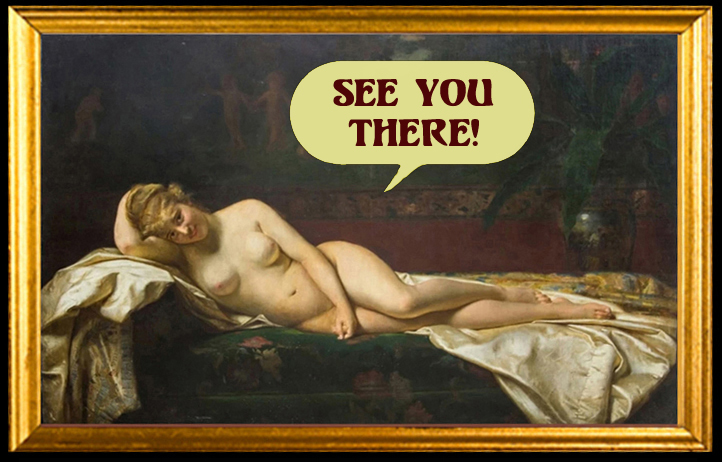
~ ~ ~ ~ ~ ~ ~ ~ ~ ~
~ ~ ~ ~ ~ ~ ~ ~ ~ ~ ~
Do you have a 'Stella'?
Do you know where one is?
...or do you have a photo of one?
Do you have a story about one?
We'd like to hear from you!

